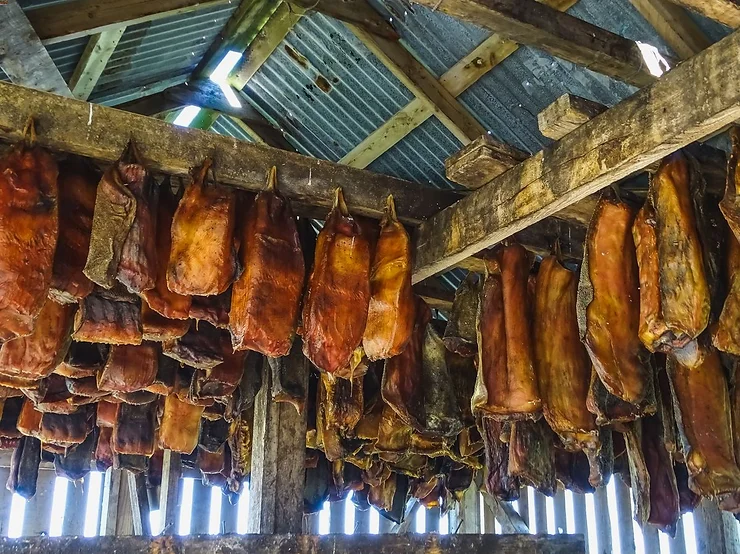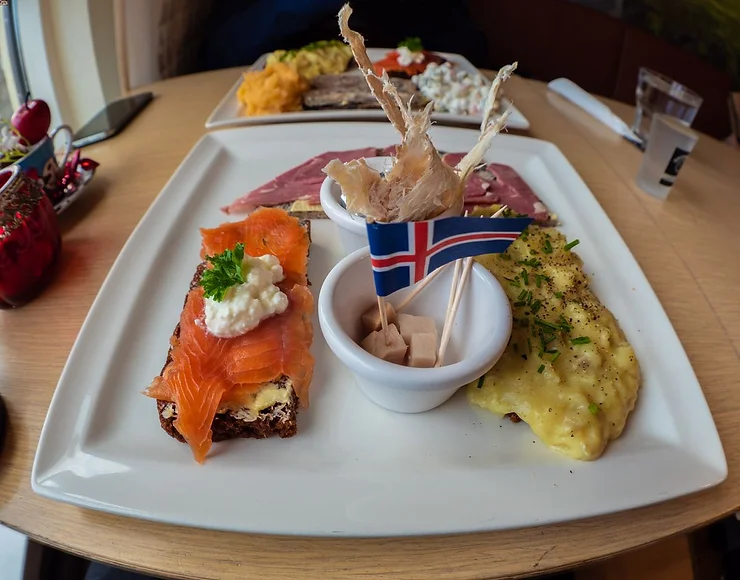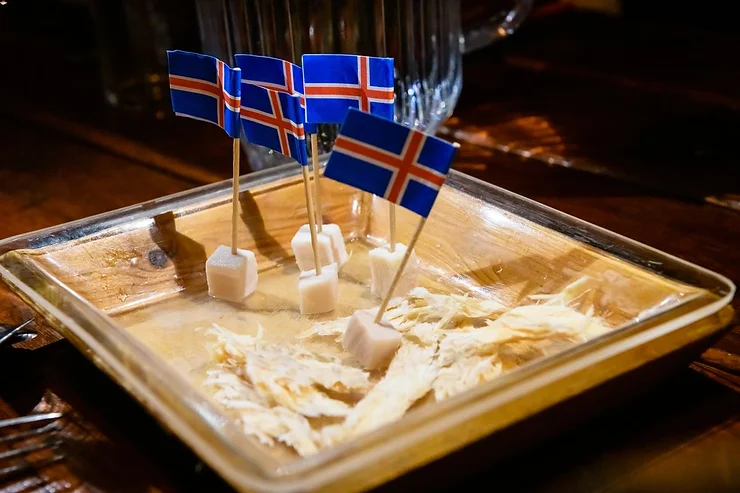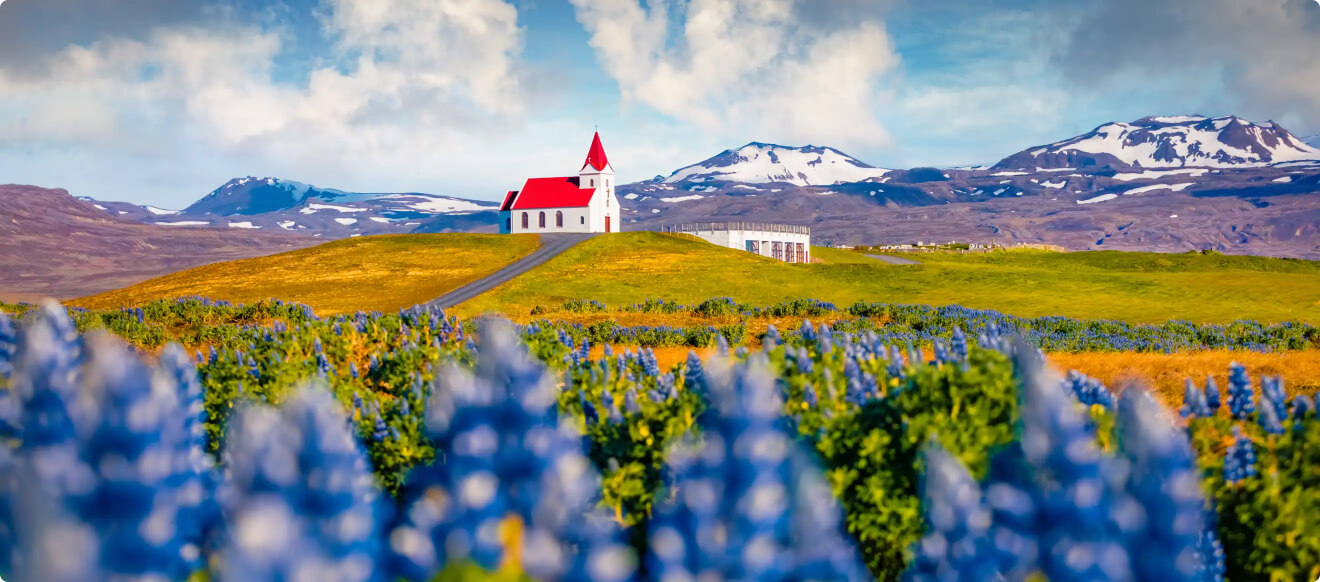Like every other country, Icelanders have developed their own mannerisms, habits and delicacies over the centuries, all based on their surroundings.
One Icelandic tradition that still survives today, although as more of a novelty, is the practice of eating fermented shark meat, or kæstur hákarl (often shortened to just hákarl). Let’s take a look at this unusual dish and how it’s made.
What is Hákarl?
Hákarl is shark meat that originates from Greenland shark and is fermented in a process which lasts several months. This process is hugely important in making the meat edible, as Greenland shark is toxic when eaten fresh. Since the shark breed lacks a urinary system, its flesh is saturated with urea and trimethylamine oxide.
The shark itself is a fascinating creature- one of the largest shark species, growing over 6 meters (20 feet) long and weighing over 1,000 kg (2,205 pounds). Incredibly, it’s also the longest-living vertebrate species, boasting an estimated lifespan of 3-500 years. These sharks don’t reach sexual maturity until 150, and live in deep water where temperatures are as low as 1 °C.
Only after a careful procedure is the meat safe to eat. This method can be traced back hundreds of years, when the preservation of food was critical to avoid starvation. Today, it perseveres as a connection to old Icelandic culture.

Hakarl curing process
Firstly, the shark must be beheaded and gutted after it is captured. Then the body is placed in a shallow hole in gravelly sand and covered over with more sand and gravel. Rocks are placed on top of the gravel to press the shark, which aids in draining it of fluids.
The shark is left like this for six to twelve weeks, a duration known as the curing period. Then the shark is exhumed, cut into strips and hung up to dry. This is the drying period and lasts for several months, during which a brown crust will develop on the outside. Afterwards, the crust is removed and the strips are cut into smaller pieces which are ready to be served as is.
When researching this dish, you may have come across the question “do they pee on hákarl?” This used to be true, but with modern practices, urine is no longer used. The urine’s purpose was to assist in the fermentation process while the shark meat was buried. While you can rest assured your hákarl will be urine-free, there’s no guarantee it will smell like it is.
What Does Hákarl Taste Like?
The first thing to note is that hákarl has a strong smell—of ammonia. Its taste is described in different ways by different people, but some words often used are fishy, nutty and cheesy. Some think hákarl tastes horrible, others love it, and for a few, it is an acquired taste after repeated consumptions.
There are two varieties: glerhákarl, which is chewy and red-colored, and skyrhákarl, which is tender and white. When celebrity chefs have sampled this meal, their reactions have been mixed. Gordan Ramsey spat it out, whereas Andrew Zimmern noted that the taste was much better than the smell.
Where to Get Hákarl in Reykjavík?
There are two places in the capital that serve hákarl: Íslenski barinn (The Icelandic Bar) and Café Loki. Both restaurants are located downtown and specialize in traditional Icelandic dishes. Additionally, you can find packaged hákarl for sale at the Kolaportið flea market, where vendors will allow you to taste some samples before purchasing.

If you want to see the process by which the fermented shark is made, visit the Bjarnarhöfn Shark Museum, located on the Snæfellsnes Peninsula. Additionally, you can learn all about the sharks that have played a significant role in Iceland’s history. Not to mention you’ll have the chance to taste some hákarl made on-site.
Make sure you head there with your Iceland trip rental car to try the most traditional bite.
How to Pronounce Hákarl?
The word is pronounced ‘how-kart-l’ with the ‘t’ and ‘l’ sounding like the ‘tl’ in ‘littler’. Now there’s no excuse not to be able to say the local delicacy’s name, but one question remains: will you be brave enough to taste it?
A Rotten bite of Iceland's Fermented Shark
Exploring the beautiful countryside isn’t the only thing you’ll be doing during your time in Iceland. You’ll also be tasting all the unique dishes on offer like Hakarl, right?
In the Land of Fire and Ice, you’ll come across meals that you won’t see anywhere else, so dive in and enjoy the local cuisine. For many of the younger locals, the only time they’ll eat some of their more unique foods is during Þorrablót.
An Icelandic midwinter festival that dates back to the 19th century, it’s named for the month Þorri on the old Icelandic calendar, which begins on the first Friday after January 19th. The Þorrablót celebration can be held any time in the month, and you can enjoy the food no matter when you visit. Therefore, get your tasting buds ready for an epic adventure!




















